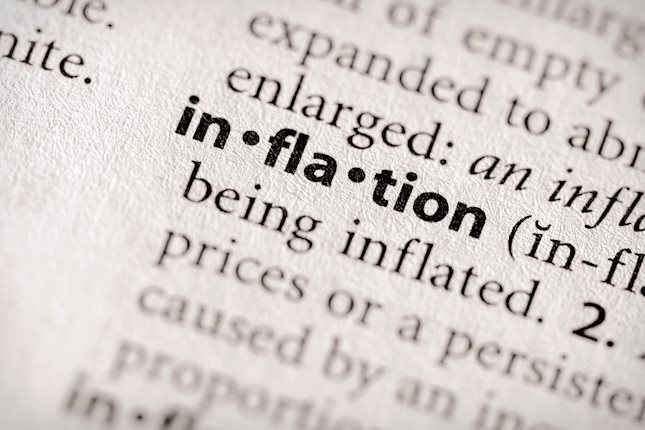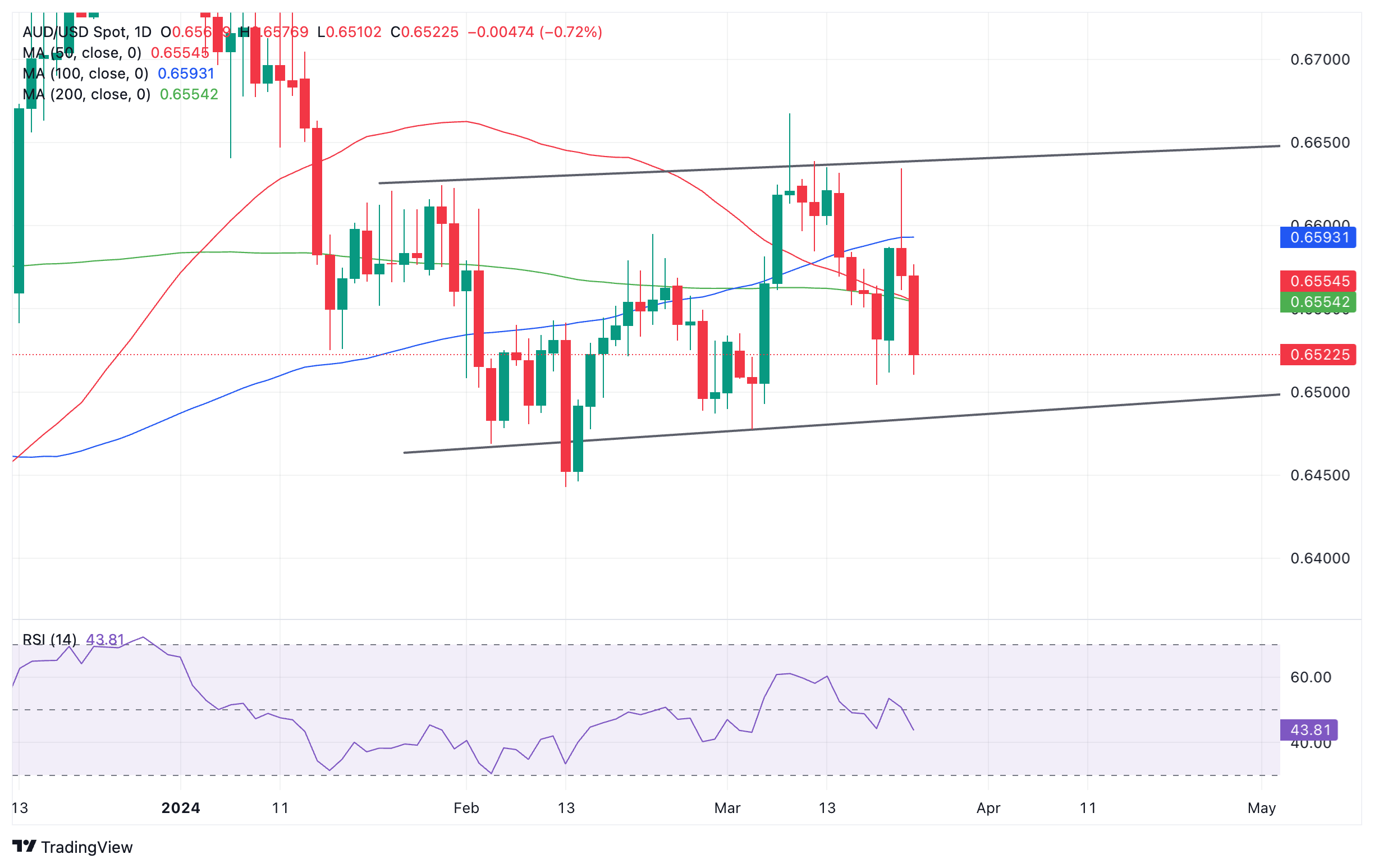- AUD/USD pitches back down to the base of its range after US data eclipses Aussie employment figures.
- The rapid reversal is surprising since the Australian data was stellar whilst the US data was unremarkable.
- A deeper analysis of the Australian jobs data might reveal why its upside influence was so ephemeral.
AUD/USD is trading back down at the bottom or its multi-week range in the lower 0.6500s on Friday, after positive US data led to a reversal in the pair from its 0.6634 Thursday highs.
Australian Dollar versus US Dollar: Daily chart
Although the US data was positive it was not remarkable. When compared to the Australian employment data that preceded it and led to such a strong surge higher in the AUD/USD on Thursday morning, it could be said to be at best mediocre.
How is it, then, that in the case of the AUD/USD pair, the US data led to such a sharp reversal lower?
US data downs the Aussie
A look at the US data in detail only intensifies the mystery further. The S&P Global US Composite PMI actually came out lower in March than the previous month, and Services PMI undershot expectations.
Whilst Manufacturing PMI beat expectations at 52.7 – making the US one of the few developed countries with an expansionary Manufacturing sector – the data hardly warranted the strong move up in the US Dollar (USD).
Granted, the other releases at the time – Initial Jobless Claims and the Philadelphia Fed Manufacturing Index – also painted a positive picture of the state of the US economy, these are still considered only at best rather minor data points.
Australian employment – a true renaissance?
Australian employment data, on the other hand, released a few hours before the US data came out, appeared at least on the surface stellar by comparison.
The Unemployment Rate fell to 3.7% from 4.1% in February, and the number of new employees hit 116,500, a number well above the average. Both data points beat expectations of 4.0% and 40,000 respectively.
A deeper dig into Australia’s labor market statistics and seasonal effects, however, suggests the incredible data in February obscured a much more modest underlying trend.
The Unemployment Rate, for example, may have fallen sharply in february but it was “around where it had been six months earlier,” according to Bjorn Davis, head of Statistics at ABS.
In terms of the unusually high Employment Change figure of 116.5K, Davis says this smooths out to a much more modest level when taken alongside the 62,000 fall in employed people in December and weaker-than-usual 15,000 rise in January. Taking the three months losses and gains together smooths the overall three-month change to a more modest 70,000 more people employed overall in February, compared to November 2023.
The data shows a lag effect because a larger-than-average number of people were waiting to start a job in December and January, that they subsequently went on to begin in February, boosting that month’s statistics.
That said, that data was still better than usual. The increase in people working from January to February was still above average, according to Davis.
“In 2022 and 2023, around 4.3 percent of employed people in February had not been employed in January. In 2024, this was higher, at 4.7 percent, and well above the pre-pandemic average for 2015 to 2020 of around 3.9 percent."
Nevertheless, a deeper understanding of the underlying statistics of February’s Australian employment release goes some way to explaining why the reaction in the Australian Dollar was a) not stronger, and b) so easily toppled by subsequent mediocre US data.
Information on these pages contains forward-looking statements that involve risks and uncertainties. Markets and instruments profiled on this page are for informational purposes only and should not in any way come across as a recommendation to buy or sell in these assets. You should do your own thorough research before making any investment decisions. FXStreet does not in any way guarantee that this information is free from mistakes, errors, or material misstatements. It also does not guarantee that this information is of a timely nature. Investing in Open Markets involves a great deal of risk, including the loss of all or a portion of your investment, as well as emotional distress. All risks, losses and costs associated with investing, including total loss of principal, are your responsibility. The views and opinions expressed in this article are those of the authors and do not necessarily reflect the official policy or position of FXStreet nor its advertisers. The author will not be held responsible for information that is found at the end of links posted on this page.
If not otherwise explicitly mentioned in the body of the article, at the time of writing, the author has no position in any stock mentioned in this article and no business relationship with any company mentioned. The author has not received compensation for writing this article, other than from FXStreet.
FXStreet and the author do not provide personalized recommendations. The author makes no representations as to the accuracy, completeness, or suitability of this information. FXStreet and the author will not be liable for any errors, omissions or any losses, injuries or damages arising from this information and its display or use. Errors and omissions excepted.
The author and FXStreet are not registered investment advisors and nothing in this article is intended to be investment advice.
Recommended content
Editors’ Picks

EUR/USD clings to gains above 1.0500 as US Dollar wilts ahead of data
EUR/USD holds its ground and trades in positive territory above 1.0500 on Wednesday. Traders cash in on the US Dollar long positions ahead of a series of top-tier US data, lifting the pair. The USD/JPY sell-off also adds to the US Dollar downside.

GBP/USD holds gains near 1.2600, US PCE data eyed
GBP/USD extends the bullish momentum to trade near 1.2600 in the second half of the day on Wednesday. The pair benefits from a sustained US Dollar weakness but the risk-off sentiment limits the upside as traders turn cautious ahead of top-tier US data releases.

Gold rises toward $2,650 as traders “buy the fact” following news of Lebanon ceasefire
Gold (XAU/USD) recovers into the $2,650s on Wednesday as traders “buy the fact” of the ceasefire deal brokered between Israel and Hezbollah after “the rumor” led to heavy selling on Monday. Market focus shifts to US data releases.

US core PCE inflation set to hold steady, raising doubts on further Federal Reserve rate cut
The United States Bureau of Economic Analysis (BEA) is set to release the Personal Consumption Expenditures (PCE) Price Index data for October on Wednesday at 15:00 GMT.

Eurozone PMI sounds the alarm about growth once more
The composite PMI dropped from 50 to 48.1, once more stressing growth concerns for the eurozone. Hard data has actually come in better than expected recently – so ahead of the December meeting, the ECB has to figure out whether this is the PMI crying wolf or whether it should take this signal seriously. We think it’s the latter.

Best Forex Brokers with Low Spreads
VERIFIED Low spreads are crucial for reducing trading costs. Explore top Forex brokers offering competitive spreads and high leverage. Compare options for EUR/USD, GBP/USD, USD/JPY, and Gold.
